My previous research is in early high-mass star formation including Giant Molecular Cloud, Infrared Dust Bubble, Hyper-Compact H II Region, Infrared Dark Cloud, Large Scale Survey, Fragmentation and Deuteration in High-mass Star Formation. With my collaborators, so far we have published eleven refereed papers, submitted two manuscripts, and been awarded many observational times on different projects and telescopes.
1. Giant Molecular Clouds
There are relatively few H2CO mappings of large-area giant molecular cloud (GMCs). H2CO absorption lines are good tracers for low-temperature molecular clouds towards star formation regions. The aim of the study was to identify H2CO distributions in ambient molecular clouds. We reported simultaneous 6-cm H2CO absorption lines and H110α radio recombination line observations and several large-area mappings at 4.8 GHz on GMCs W49, W3, DR21/W75, and NGC2024/NGC2023. (Zhang et al., 2012)

2. Hyper-Compact HII Regions
The formation of hypercompact (HC) H II regions is an important stage in massive star for- mation. Spectral line and continuum observations can explore its dynamic conditions. We presented high angular resolution observations carried out with the SMA and VLA toward the HC H II region G35.58-0.03. With the 1.3 mm SMA and 1.3 cm VLA, we detected a total of about 25 transitions of 8 different species and their isotopologues (CO, CH3CN, S2O , CH3CCH, OCS, CS, H30α H38β, and NH3). (Zhang et al., 2014)
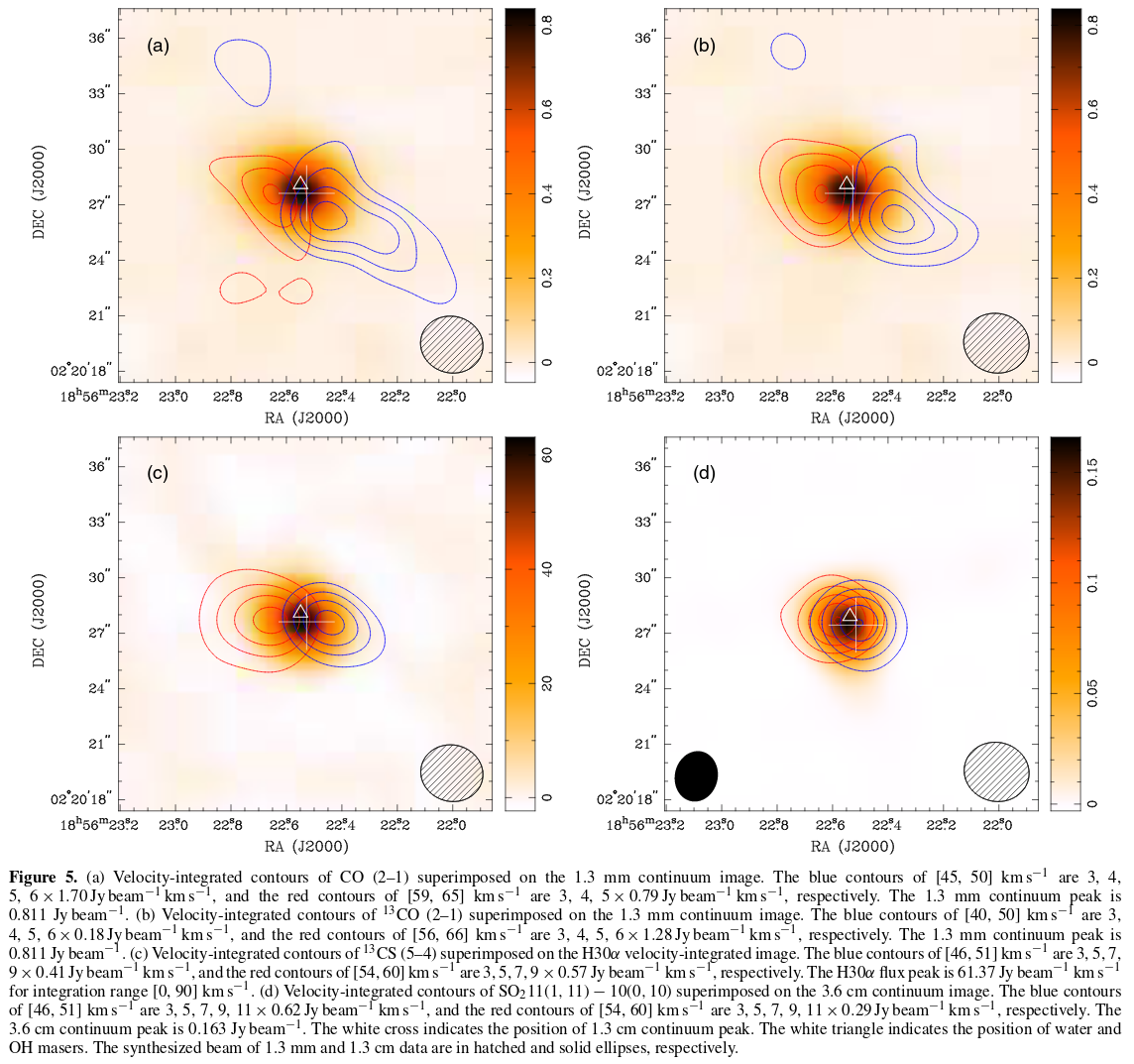
3. Infrared Dust Bubbles
OB type stars have strong ionizing radiation, and drive energetic winds. The ultraviolet (UV) radiation from ionizing stars may heat dust and ionize gas to sweep up an expanding bubble shell. This shell may be the result of feedback leading to a new generation of stars in bubbles. We studied the formation and fragmentation of bubbles S51, N68, N131 with multi-wavelength dust and gas observations. Particularly, we propose a scenario in which the bubble N131 forms from the disruption of a gas filament by strong stellar winds, and fragments under self-gravity. (Zhang & Wang, 2012, 2013; Zhang et al., 2013; Xu et al., 2014; Zhang et al., 2016a)

4. Infrared Dark Cloud
Infrared dark clouds (IRDCs) are ubiquitous in the Milky Way, yet they play a crucial role in breeding newly-formed stars. With the aim of further understanding the dynamics, chem- istry, and evolution of IRDCs, we performed new observations with the IRAM 30 m and CSO10.4 m telescopes, with tracers HCO+, HCN, N2H+ , C18O, DCO+, SiO, and DCN toward six IRDCs G031.97+00.07, G033.69-00.01, G034.43+00.24, G035.39-00.33, G038.95-00.47, and G053.11+00.05. We observed many blueshifted and redshifted profiles, respectively, with HCO+ and C18O toward the same core. This case can be well explained by model “envelope expansion with core collapse (EECC)”. (Xu et al., 2016; Zhang et al., 2016b)
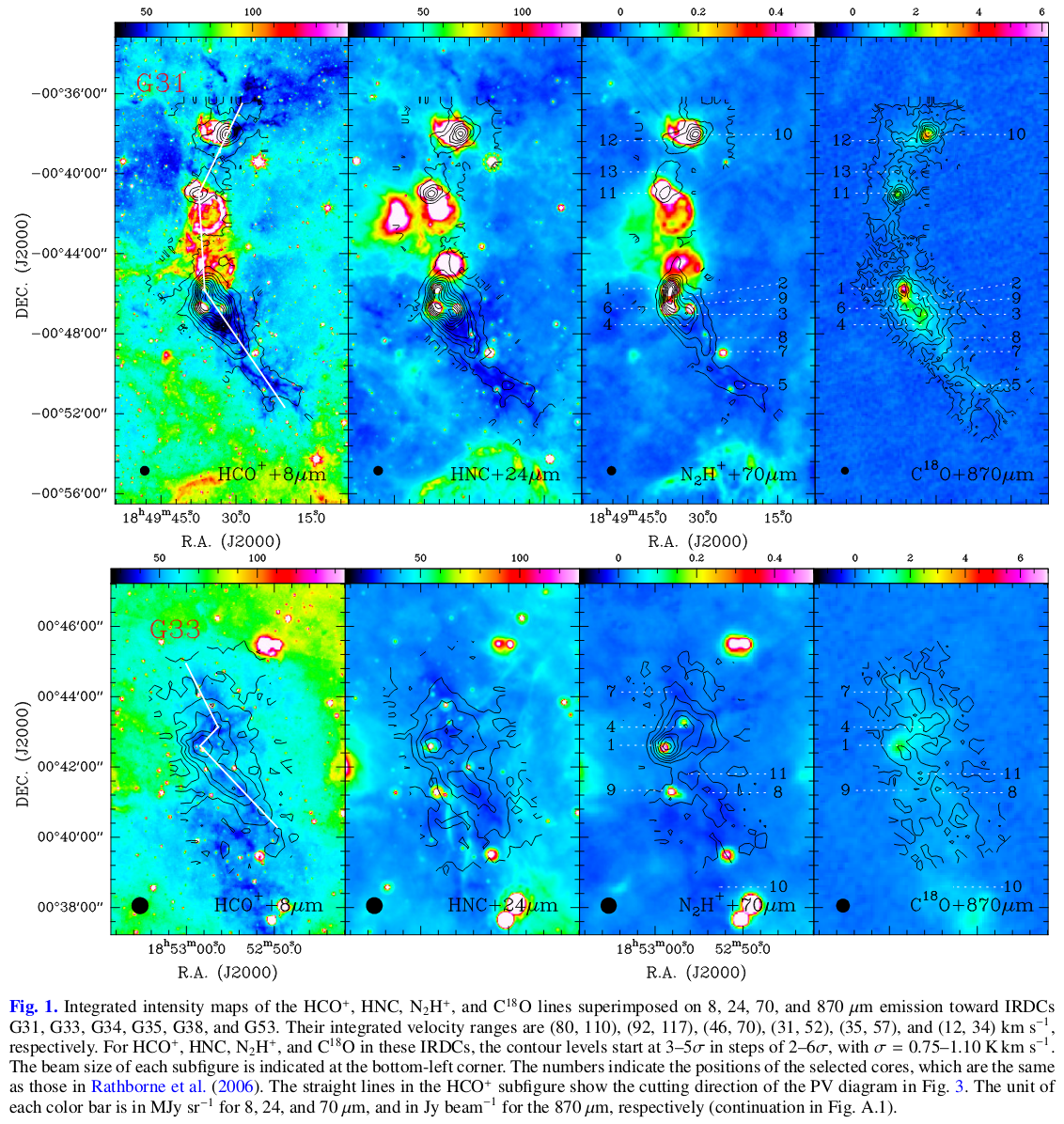
5. Large Scale Survey
TOP-SCOPE are joint survey programs targeting at Planck Cold Clumps. TOP, standing for “TRAO Observations of Planck cold clumps”, aims at an unbiased CO survey of 2000 Planck Galactic Cold Clumps with the TRAO 14-m telesope. SCOPE, standing for “SCUBA- 2 Continuum Observations of Pre-protostellar Evolution”, is a legacy survey using SCUBA-2 onboard of the JCMT at East Asia Observatory to survey 1000 Planck galactic cold clumps at 850 μm. I am leading a subproject to study the gas and dust of 64 Planck Cold Cores in the Second Quadrant of the Milky Way.
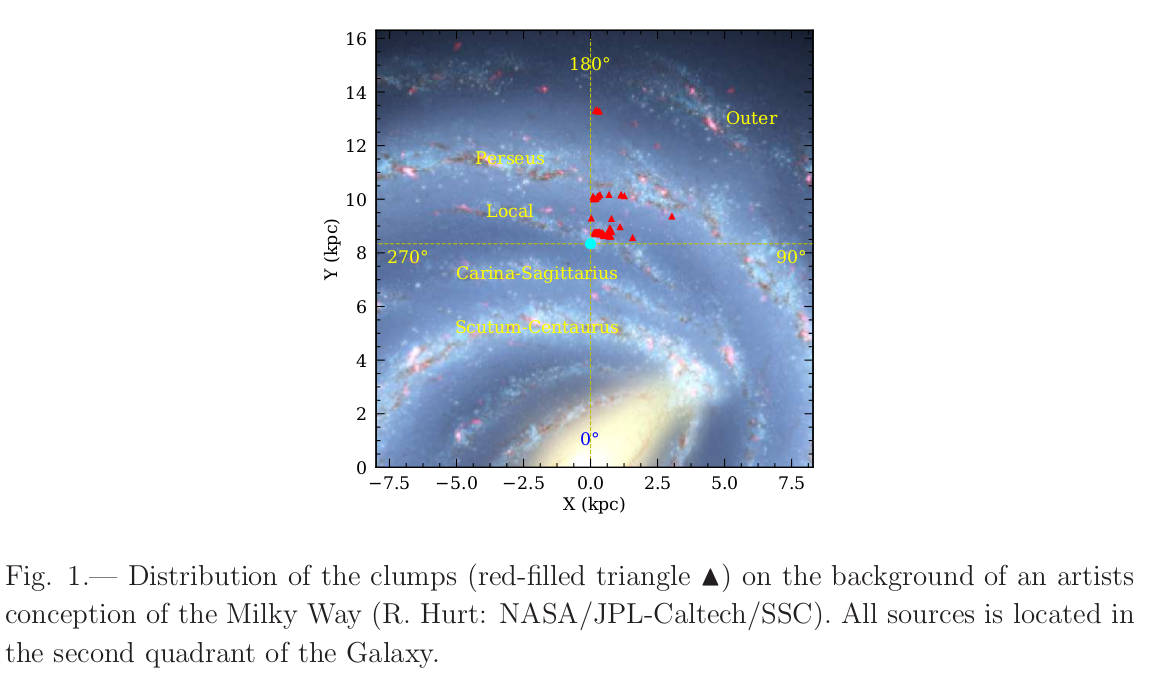
6. Fragmentation and triggered star formation
Context. Fragmentation and feedback are two important processes during the early phases of star formation.
Aims. Massive clumps tend to fragment into clusters of cores and condensations, some of which form high-mass stars. In this work, we study the structure of massive clumps at different scales, analyze the fragmentation process, and investigate the possibility that star formation is triggered by nearby H II regions.
Methods. We present a high angular resolution study of a sample of massive proto-cluster clumps G18.17, G18.21, G23.97N, G23.98, G23.44, G23.97S, G25.38, and G25.71. Combining infrared data at 4.5, 8.0, 24, and 70 μm, we use few-arcsecond resolution radio- and millimeter interferometric data taken at 1.3 cm, 3.5 mm, 1.3 mm, and 870 μm to study their fragmentation and evolution. Our sample is unique in the sense that all the clumps have neighboring H II regions. Taking advantage of that, we test triggered star formation using a novel method where we study the alignment of the centres of mass traced by dust emission at multiple scales.
Results. The eight massive clumps, identified based on single dish observations, have masses ranging from 228 to 2279 Msun within an effective radius of R eff ∼ 0.5 pc. We detect compact structures towards six out of the eight clumps. The brightest compact structures within infrared bright clumps are typically associated with embedded compact radio continuum sources. The smaller scale structures of R eff ∼ 0.02 pc observed within each clump are mostly gravitationally bound and massive enough to form at least a B3-B0 type star. Many condensations have masses larger than 8 Msun at small scale of R eff ∼ 0.02 pc. We find that the two lowest mass and lowest surface density infrared quiet clumps with < 300 Msun do not host any compact sources, calling into question their ability to form high-mass stars. Although the clumps are mostly infrared quiet, the dynamical movements are active at clump scale (∼ 1 pc).
Conclusions. We studied the spatial distribution of the gas conditions detected at different scales. For some sources we find hints of external triggering, whereas for others we find no significant pattern that indicates triggering is dynamically unimportant. This probably indicates that the different clumps go through different evolutionary paths. In this respect, studies with larger samples are highly desired.
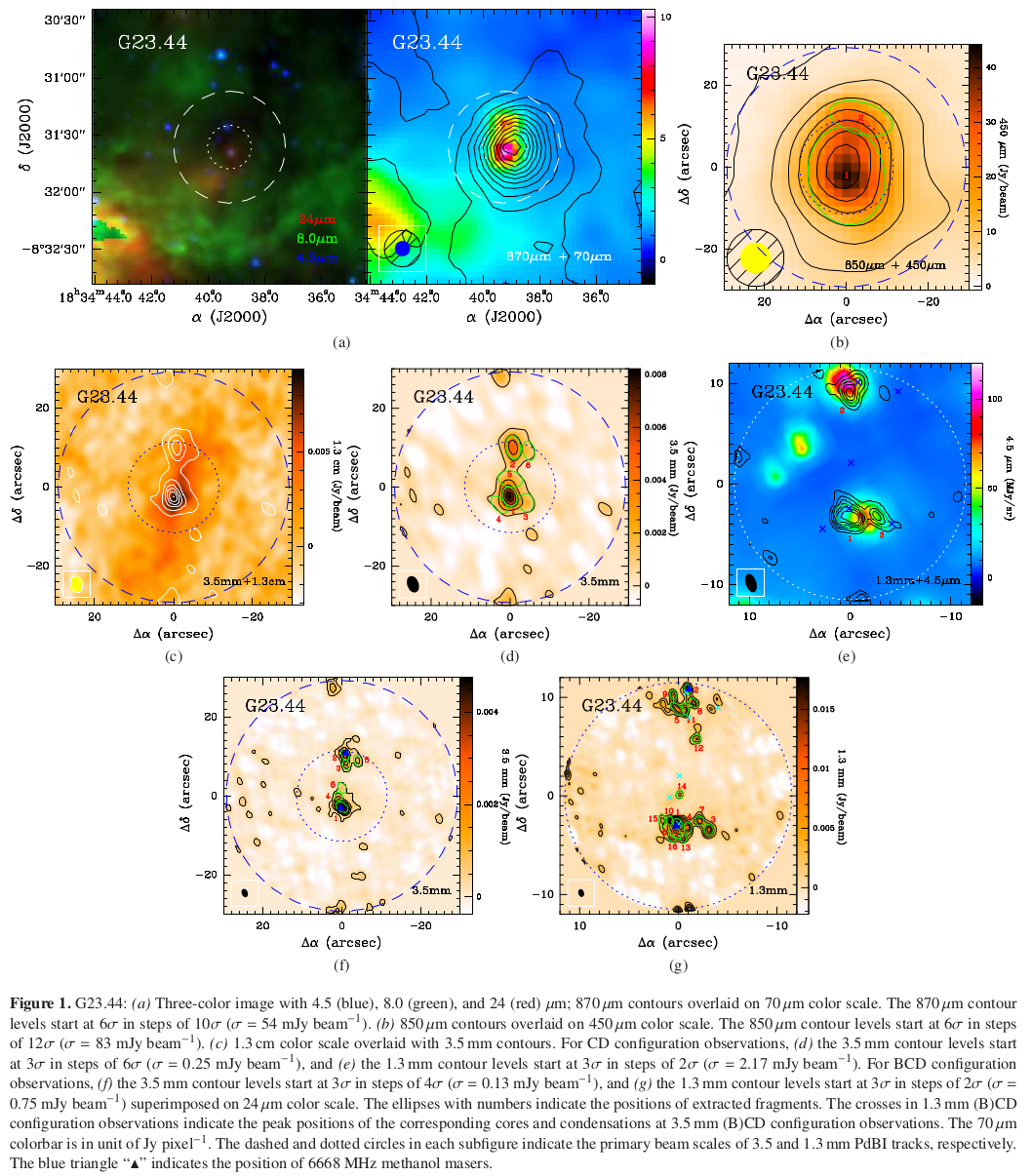
7. Gas dynamics and NH2D chemistry in high-mass pre/protocluster clumps
Context. The initial stage of star formation is very difficult to study due to its high density (n H 2 > 10^6 cm^−3 ) and low temperature (T dust < 18 K), which lead to many molecules depleted from the gas phase by freezing out onto dust grains. However, the deuterium species like the 1 11 -1 01 lines of o-NH2D at 85.926 GHz could survive in the extreme condition.
Aims. Deuterated specie NH2D as a tracer was observed to probe the initial conditions of high-mass star formation, and high spatial resolution observations of NH3 (1, 1) and (2, 2) are used to investigate the temperature and dynamics of the dense and cold objects.
Methods. We present NH2D, NH3 (1, 1) and (2, 2) observations using PdBI and VLA, respectively, towards eight massive precluster clumps (G18.17, G18.21, G23.97N, G23.98, G23.44, G23.97S, G25.38, and G25.71). We use 3D Gaussclumps to extract NH2D cores and provide a statistical view of their deuterium chemistry.
Results. We find that the NH2D cores are gravitationally bound, and can potentially form intermediate- or high-mass stars in future. The NH2D emission is not associated with either a dust continuum or NH3 peak position or infrared source, but just surrounding the central continuum cores, suggesting that the NH2D has been destroyed by the central young stellar object (YSO) due to its heating. The NH2D cores are likely prestellar or starless cores. We detect extremely high deuterium fractionation of 0.03 6 D frac 6 1.41 with a median value of 0.45 ± 0.01. We find that the correlation between D frac and T kin is a positive-correlation from 13 to 16.5 K, but anti-correlation from 16.5 to 22 K. The most suitable condition for NH2D to take place reaction may be at the temperature of around 16.5 K. The detected NH2D lines are very narrow with a median value of around 0.94 ± 0.09 km/s, which is regulated by turbulent broadening. Using NH3 (1, 1) as a dynamical tracer, we find very complicated dynamical movement towards all the eight clumps, as can be explained by processes such as outflow, rotation, convergent flow, collision, and large velocity gradient.
Conclusions. The sample generally exhibit clear signatures of Keplerian disk, suggesting that the accretion rate could be increasing gradually from prestellar core to evolved source stages.
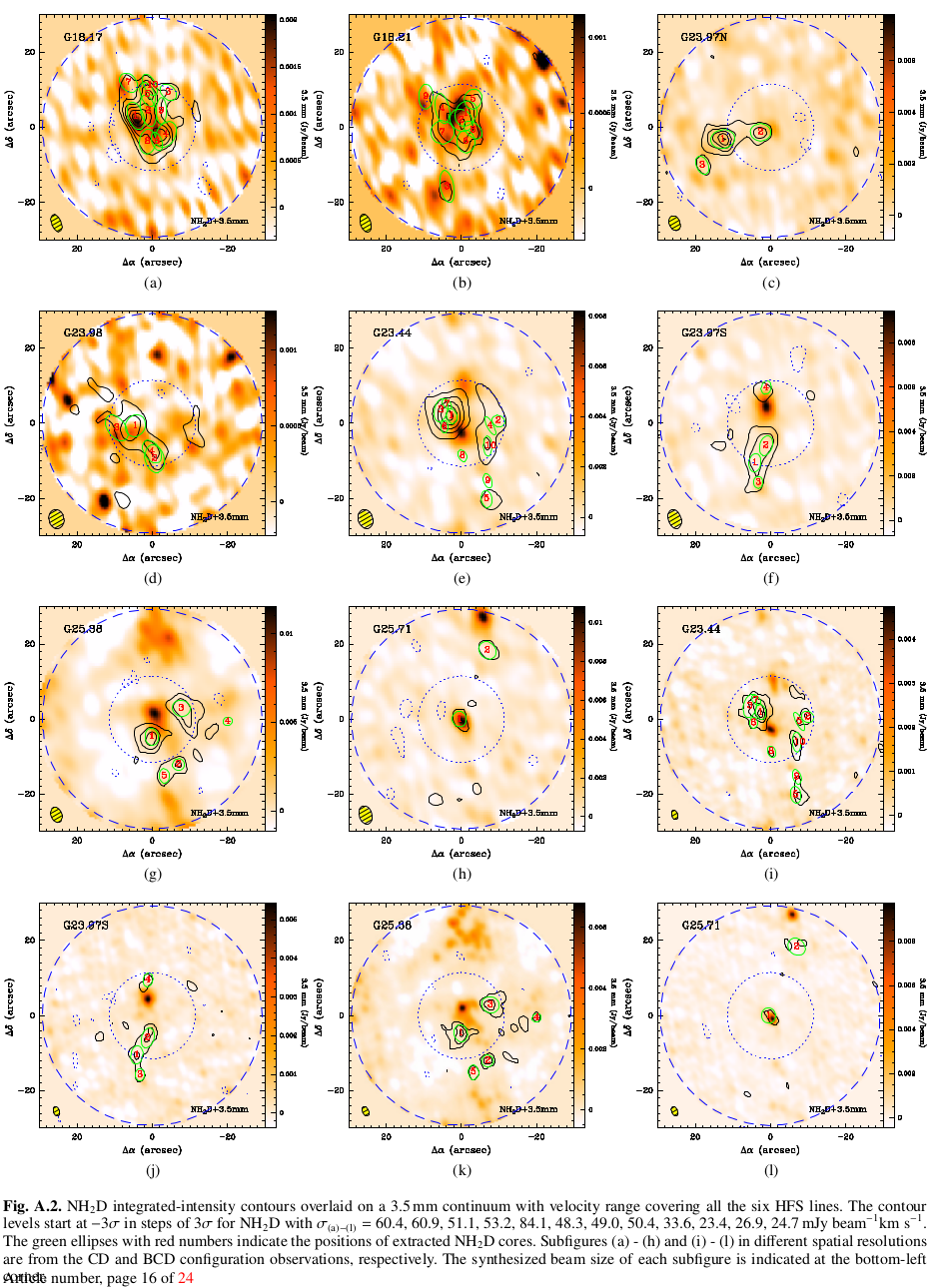
References
Xu, J.-L., Li, D., Zhang, C.-P., et al. 2016, ApJ, 819, 117
Xu, J.-L., Wang, J.-J., Ning, C.-C., & Zhang, C.-P. 2014, Research in Astronomy and Astrophysics, 14, 47
Zhang, C.-P., Esimbek, J., Zhou, J. J., Wu, G., & Du, Z. M. 2012, Ap&SS, 337, 283
Zhang, C.-P., Li, G.-X., Wyrowski, F., et al. 2016a, A&A, 585, A117
Zhang, C.-P. & Wang, J. J. 2012, A&A, 544, A11
Zhang, C.-P. & Wang, J.-J. 2013, Research in Astronomy and Astrophysics, 13, 47
Zhang, C.-P., Wang, J.-J., & Xu, J.-L. 2013, A&A, 550, A117
Zhang, C.-P., Wang, J.-J., Xu, J.-L., Wyrowski, F., & Menten, K. M. 2014, ApJ, 784, 107
Zhang, C.-P., Yuan, J.-H., Li, G.-X., Zhou, J.-J., & Wang, J.-J. 2016b, ArXiv: 1611.08794